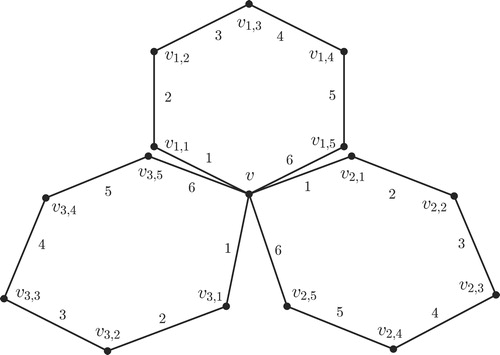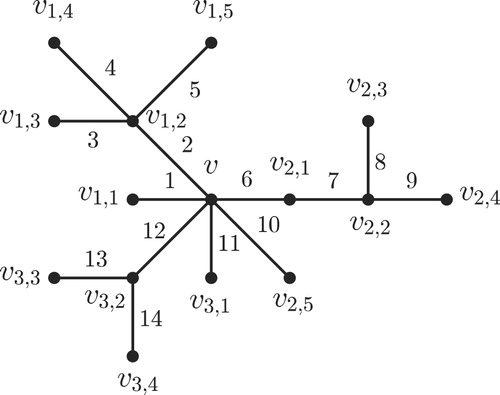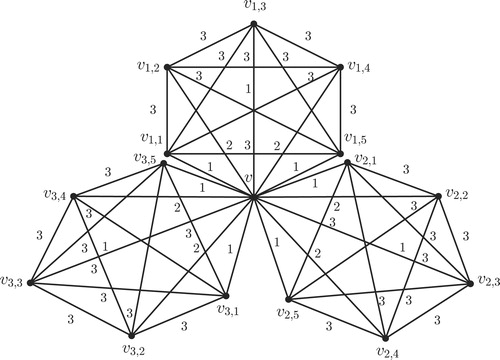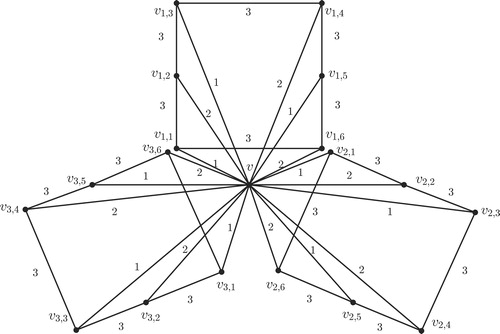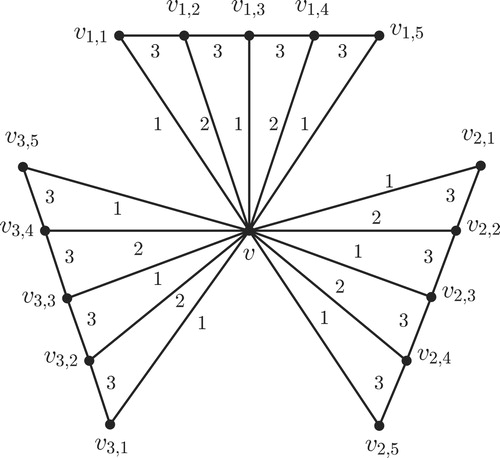Abstract
Let be a nontrivial connected graph. For
, we define a coloring
of the edges of
such that adjacent edges can be colored the same. A path
in
is a rainbow path if no two edges of
are colored the same. A rainbow path connecting two vertices
and
in
is called rainbow
–
path. A graph
is said rainbow-connected if for every two vertices
and
of
, there exists a rainbow
–
path. In this case, the coloring
is called a rainbow
-coloring of
. The minimum
such that
has a rainbow
-coloring is called the rainbow connection number of
.
For and
, let
be a finite collection of graphs and each
has a fixed vertex
called a terminal. The amalgamation
is a graph formed by taking all the
’s and identifying their terminals.
We give lower and upper bounds for the rainbow connection number of for any connected graph
. Additionally, we determine the rainbow connection number of amalgamation of either complete graphs, or wheels, or fans.
1 Introduction
All graphs in this paper are simple, finite, and undirected. The concept of rainbow coloring was introduced by Chartrand et al. [Citation1]. Let be a nontrivial connected graph. For
, we define a coloring
of the edges of
such that adjacent edges can be colored the same. A path
in
is a rainbow path if no two edges of
are colored the same. A rainbow path connecting two vertices
and
in
is called rainbow
path. A graph
is said rainbow-connected if for every two vertices
and
of
, there exists a rainbow
path. In this case, the coloring
is called a rainbow k-coloring of
. The minimum
such that
has a rainbow
-coloring is called the rainbow connection number
of
. Clearly
where
denotes the diameter of
.
Chartrand et al. [Citation1] determined the rainbow connection number for some classes of graphs. They showed that if and only if
is a complete graph, and
if and only if
is a tree. They also determined the rainbow connection number of cycles and wheels. In [Citation2], Syafrizal Sy et al. determined the rainbow connection number of fans. The rainbow connection numbers of some other graph classes, namely flower
graphs, origami graphs, pizza graphs,
crossed prism graphs, pencil graphs, rocket graphs, and stellar graphs can be seen in [Citation3–Citation[4]Citation[5]Citation[6]Citation7], and [Citation8]. Chakraborty et al. [Citation9] showed that computing the rainbow connection number of a graph is NP-Hard.
There are some results about rainbow connection number of graphs resulted from graph operations. Li and Sun [Citation10] obtained some results on bounds for rainbow connection number of product of graphs, including Cartesian product, composition (lexicographic product), and join of graphs. Basavaraju et al. [Citation11] determined bounds for rainbow connection number of graphs that are obtained by Cartesian product, lexicographic product, strong product, and the operation of taking the power of graph according to the radius of graphs. Gologranc et al. [Citation12] investigated bounds for rainbow connection number on direct, strong, and lexicographic product of graphs. An overview about rainbow connection number can be found in a survey by Li et al. [Citation13] and a book of Li and Sun [Citation14].
2 Main results
The following definition of an amalgamation of graph is taken from [Citation15]. For and
, let
be a simple connected graph and
for some
. For
, let
be a finite collection of graphs and each
, has a fixed vertex
called a terminal. The amalgamation
is a graph formed by taking all the
’s and identifying their terminals.
Let . We denote the identified vertex as
and define
.
The following theorem provides a sharp lower and upper bound for the rainbow connection number of amalgamation of arbitrary graphs.
Theorem 2.1
For , let
be a finite collection of graphs and each
has a fixed vertex
called a terminal. If
is the amalgamation of
,
, then
Proof
We obtain the lower bound by the fact that . Let
be a rainbow
-coloring of
. We define a coloring
as follows.
We consider any two vertices
.
| Case 1. | = |
There exists a rainbow |
| Case 2. | = |
There exists a rainbow |
So, is a rainbow coloring. Thus,
. □
In the next two theorems, we prove the existence of an amalgamation graph whose rainbow connection number satisfies either the lower or upper bound in Theorem 2.1.
Theorem 2.2
Let and
be two positive integers with
and
. Let
where for each
,
is a cycle
. For even
and
, or odd
and
,
.
Proof
By Theorem 2.1, we only need to show that . We define
| Case 1. | = |
We can check that
|
| Case 2. | = |
We can check that
|
Theorem 2.3
Let be a positive integer with
and
where for each
,
is an arbitrary tree
. Then
.
Proof
We obtain that is also a tree and
. By [Citation9], we get
. □
For illustration of Theorems 2.2 and 2.3, see and , respectively.
Next, we consider amalgamation of cycles for any odd
and
. We show that its rainbow connection number is between lower and upper bounds in Theorem 2.1.
Theorem 2.4
Let and
be two positive integers with
and
. Let
where for each
,
is a cycle
. For odd
and
,
.
Proof
We can check that . By similar coloring in Case 1 of Theorem 2.2, we obtain that
. Assume to the contrary that
. Let
Next, we determine the rainbow connection number of amalgamation of either complete graphs, or wheels, or fans respectively in Theorems 2.6Theorem 2.7–2.8. Let be a vertex in a wheel
or a fan
where the degree of
is
. Vertex
is called the center vertex. We can check that the amalgamation of either wheels or fans has diameter 2 where vertex
be the identified vertex of amalgamation of either wheels or fans. Meanwhile, we can also check that the amalgamation of any complete graphs has diameter 2.
The following definitions are taken from [Citation16]. A maximal connected subgraph of is called a component of
. Let
be a subset of
.
separates in
if subgraph of
induced by
is disconnected. A vertex which separates two other vertices of the same component is a cut vertex, and an edge separating it ends is a bridge.
The amalgamation of either complete graphs, or wheels, or fans also has a cut vertex, namely the identified vertex . Li et al. [Citation17] obtained upper bounds for rainbow connection number of bridgeless graphs with diameter 2 in the following lemma.
Lemma 2.5
[Citation17]
Let be a bridgeless graph with diameter 2. If
has a cut vertex, then
.
Now, we provide the rainbow connection number of amalgamation of complete graphs.
Theorem 2.6
Let and
be two positive integers with
and
. Let
where for each
is a complete graph
. Then
Proof
We define
| Case 1. | = | We define a coloring |
| Case 2. | = | We define a coloring
|
Proof of lower bound consists of two cases.
| Case 1. | = | Since |
| Case 2. | = | Assume to the contrary that |
Hence, □
Next, we provide the rainbow connection number of amalgamation of wheels in the following theorem.
Theorem 2.7
Let and
be two positive integers with
and
. Let
where for each
,
is a wheel
with
vertices. If
for
is the center vertex of
, then
Proof
We define
| Case 1. | = |
We define a coloring |
| Case 2. | = |
We define a coloring
|
Hence,
Proof of lower bound consists of three cases.
| Case 1. | = |
Since | ||||||
| Case 2. | = |
Assume to the contrary that | ||||||
| Case 3. | = |
Assume to the contrary that Since there is no rainbow path between any two vertices in the same copies of
|
Hence, □
The following theorem shows the rainbow connection number of amalgamation of fans.
Theorem 2.8
Let and
be two positive integers with
and
. Let
where for each
,
is a fan
with
vertices. If
for
is the center vertex of
, then
Proof
We define
| Case 1. | = |
We define a coloring |
| Case 2. | = |
We define a coloring |
Hence,
Proof of lower bound consists of three cases.
| Case 1. | = |
Since |
| Case 2. | = |
Assume to the contrary, that |
| Case 3. | = |
Assume to the contrary that Since |
Hence, □
For illustration of Theorems 2.6Theorem 2.7–2.8, see –, respectively.
Notes
Peer review under responsibility of Kalasalingam University.
References
- G.ChartrandG.L.JohnsK.A.Mc KeonP.ZhangRainbow connection in graphsMath Bohem.133120088598
- SyafrizalSyG.H.MedikaL.YuliantiThe rainbow connection number of fan and sunAppl. Math. Sci.7201331553160
- S.K.IrvaniaA.N.M.SalmanThe rainbow connection number of a flower graph and a flower graphProcedia Comput. Sci.42015168172
- S.NabilaA.N.M.SalmanThe rainbow connection number of origami graphs and pizza graphsProcedia Comput. Sci.42015162167
- D.RestyA.N.M.SalmanThe rainbow connection number of an -crossed prism graph and its corona product with a trivial graphProcedia Comput. Sci.42015143150
- D.N.S.SimamoraA.N.M.SalmanThe rainbow (vertex) connection number of pencil graphsProcedia Comput. Sci.42015138142
- M.A. Shulhany, A.N.M. Salman, The (strong) rainbow connection number of stellar graphs, in: Proceedings of International Seminar on Mathematics, Science, and Computer Science Education, MSCEIS 2015, AIP Conf. Proc. 1708, pp. 060007-1–060007.
- Susilawati, A.N.M Salman, Rainbow connection number of rocket graphs, in: The 5th International Conference on Mathematics and Natural Sciences, AIP Conf. Proc. 1677, 2015, pp. 030012-1–030012-3.
- S.ChakrabortyE.FischerA.MatsliahR.Yuster, RHardness and algorithms for rainbow connectionJ. Comb. Optim.212011330347
- X.LiY.SunCharacterization of graphs with large rainbow connection number and rainbow connection numbers of some graph operationsDiscrete Math.2016 in press
- M.BasavarajuL.S.ChandranD.RajendraprasadA.RamaswamyRainbow connection number of graph power and graph productsGraphs Combin.201310.1007/s00373-013-1355-3
- T.GolograncG.MekisI.PeterinRainbow connection and graph productsGraphs Combin.201310.1007/s00373-013-1295-y
- X.LiY.ShiY.SunRainbow connection of graphs: a surveyGraphs Combin.2912013138
- X.LiY.SunRainbow Connection of Graphs2012Springer-VerlagNew York
- K.CarlsonGeneralized books and -snakes are prime graphsArs Combin.802006215221
- R.DiestelGraph Theory2006SpringerGermany
- H.LiX.LiS.LiuRainbow connection of graphs with diameter 2Discrete Math.312201214531457

